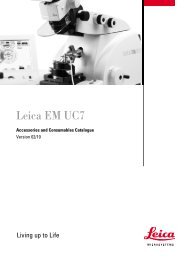Physical Principles of Electron Microscopy: An Introduction to TEM ...
Physical Principles of Electron Microscopy: An Introduction to TEM ...
Physical Principles of Electron Microscopy: An Introduction to TEM ...
You also want an ePaper? Increase the reach of your titles
YUMPU automatically turns print PDFs into web optimized ePapers that Google loves.
The Scanning <strong>Electron</strong> Microscope 151<br />
5.9 <strong>Electron</strong>-Beam Lithography<br />
<strong>Electron</strong>s can have a permanent effect on an electron-microscope specimen,<br />
generally known as radiation damage. In inorganic materials, high-energy<br />
electrons that are “elastically” scattered through large angles can transfer<br />
enough energy <strong>to</strong> a<strong>to</strong>mic nuclei <strong>to</strong> displace the a<strong>to</strong>ms from their lattice site in<br />
a crystal, creating displacement damage visible in a <strong>TEM</strong> image, such as the<br />
point-defect clusters shown in Fig. 4-16. In organic materials, radiation<br />
damage occurs predominantly as a result <strong>of</strong> inelastic scattering; the bonding<br />
configuration <strong>of</strong> valence electrons is disturbed, <strong>of</strong>ten resulting in the<br />
permanent breakage <strong>of</strong> chemical bonds and the destruction <strong>of</strong> the original<br />
structure <strong>of</strong> the solid. This makes it difficult <strong>to</strong> perform high-resolution<br />
microscopy (<strong>TEM</strong> or SEM) on organic materials, such as polymers (plastics)<br />
and<br />
impossible <strong>to</strong> observe living tissue at a subcellular level.<br />
However, radiation damage is put <strong>to</strong> good use in polymer materials<br />
known as resists, whose purpose is <strong>to</strong> generate structures that are<br />
subsequently transferred <strong>to</strong> a material <strong>of</strong> interest, in a process referred <strong>to</strong> as<br />
lithography. In a positive resist, the main radiation effect is bond breakage.<br />
As a result, the molecular weight <strong>of</strong> the polymer decreases and the material<br />
becomes more soluble in an organic solvent. If an SEM is modified slightly<br />
by connecting its x and y deflection coils <strong>to</strong> a pattern genera<strong>to</strong>r, the electron<br />
beam is scanned in a non-raster manner and a pattern <strong>of</strong> radiation damage is<br />
produced in the polymer. If the polymer is a thin layer on the surface <strong>of</strong> a<br />
substrate, such as a silicon wafer, subsequent “development” in an organic<br />
solvent results in the scanned pattern appearing as a pattern <strong>of</strong> bare substrate.<br />
The undissolved areas <strong>of</strong> polymer form a barrier <strong>to</strong> chemical or ion-beam<br />
etching <strong>of</strong> the substrate (Section 4.10), hence it acts as a “resist.” After<br />
etching and removing the remaining resist, the pattern has been transferred<br />
<strong>to</strong> the substrate and can be used <strong>to</strong> make useful devices, <strong>of</strong>ten in large<br />
number. The fabrication <strong>of</strong> silicon integrated circuits (such as computer<br />
chips) makes use <strong>of</strong> this process, repeated many times <strong>to</strong> form complex<br />
multilayer structures, but using ultraviolet light or x-rays as the radiation<br />
source. <strong>Electron</strong>s are used for smaller-scale projects, requiring high<br />
resolution but where production speed (throughput) is less important. Resist<br />
exposure is done using either a specialized electron-beam writer or an SEM.<br />
In a negative resist, radiation causes an increase in the extent <strong>of</strong> chemical<br />
bonding (by “cross-linking” organic molecules), giving an increase in<br />
molecular weight and a reduction in solubility in exposed areas. After<br />
development, the pattern is a “negative” <strong>of</strong> the beam-writing pattern, in the<br />
sense that resist material remains in areas where the beam was present<br />
(similar <strong>to</strong> undissolved silver in a black-and-white pho<strong>to</strong>graphic negative).



